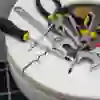Share:
If you've ever walked into your bathroom, ready to use the toilet, only to find that the seat is cracked, you’ll understand the frustration and inconvenience of dealing with a problematic toilet seat.
Most cracked toilet seats start as wobbly seats and can be a real nuisance. Not only are these seats uncomfortable to sit on, but they can also be embarrassing when guests come over.
But fear not, as fixing a cracked toilet seat is a simple task that you can do on your own with just a few basic tools and a little bit of know-how, for a temporary fix until you're ready to purchase a new one.
Here, The Bathroom Showroom offers a quick guide to walk you through the steps of fixing your toilet seat with ease.

Why Do Toilet Seats Crack?
Toilet seats can crack for a variety of reasons, and while sunlight exposure and material quality are significant factors, they're part of a larger picture of wear and tear. Here's a breakdown of the main culprits:
1. Material and Manufacturing
The type of material used for a toilet seat has a major impact on its durability.
- Polypropylene and Thermoplastic: These are common plastic materials. They are generally lightweight and affordable but can become brittle and crack over time due to aging and repeated stress.
- Duroplast: A high-quality thermoset plastic, Duroplast is known for its durability and resistance to scratches and cleaning chemicals. It's less likely to crack than cheaper plastics.
- Wood: Wooden toilet seats, often made from materials like mahogany, pine, or MDF (Medium-Density Fiberboard), can also crack. Exposure to moisture can cause the wood to swell and warp, leading to cracks, especially if the surface finish or varnish is compromised.
- Resin and Acrylic: These materials offer a sleek, high-end look but can be prone to cracking if a heavy object is dropped on them or if they are subjected to impact.
2. Sunlight and UV Radiation
Sunlight, specifically its ultraviolet (UV) rays, can be a major factor in the degradation of plastic toilet seats.
- UV Degradation: UV radiation breaks down the chemical bonds in plastics, a process known as photodegradation. This makes the material brittle and prone to cracking.
- Discoloration: UV exposure also causes the plastic to yellow or discolor over time, which is a visible sign of this degradation.
- Location: While most bathrooms don't get direct, intense sunlight, a bathroom with a window that receives a lot of sun can accelerate this process.
3. Physical Stress and Use
Everyday use and accidental impacts are leading causes of cracks.
- Incorrect Installation: A toilet seat that is not installed properly can be loose or stressed, which puts pressure on the seat and hinges and can lead to cracking. Over-tightening the bolts can also cause stress fractures.
- Misuse: Standing on the seat, dropping heavy objects on it, or forcefully slamming the lid can cause immediate cracks or contribute to stress fractures that will eventually break.
- Weight: While toilet seats are designed to accommodate a certain amount of weight, exceeding this limit or unevenly distributing weight can cause the seat to flex and eventually crack.
4. Other Environmental Factors
- Temperature Changes: Extreme temperature fluctuations, either hot or cold, can cause materials to expand and contract. This constant change can weaken the seat and lead to cracks.
- Cleaning Chemicals: Harsh or abrasive cleaning products can erode the surface of the toilet seat, weakening the material and making it more susceptible to cracking.
How Long Do Toilet Seats Last?
The lifespan of a toilet seat can vary significantly based on a number of factors, but on average, you can expect a toilet seat to last 5 to 7 years. Some sources say it can be anywhere from 5 to 10 years, or even longer in some cases.

Signs It's Time to Replace Your Toilet Seat
Even if it hasn't reached the 5-7 year mark, you should consider replacing your toilet seat if you notice:
- Cracks or damage: Cracks, especially around the hinges, can be a breeding ground for bacteria.
- Persistent looseness: If you're constantly having to tighten a wobbly seat, it's a sign that the hinges or the mounting points are worn out.
- Stains or discoloration: If the seat has become stained, discolored, or yellowed, and cleaning doesn't help, it's time for a new one for aesthetic and hygienic reasons.

Temporary Fixes for a Cracked or Broken Toilet Seat
While the best solution for a broken or cracked toilet seat is to replace it, there are a few temporary fixes you can use to get by until you can get a new one. These methods are not meant to be permanent and may not be aesthetically pleasing, but they can prevent the seat from pinching your skin and provide some stability.
Here are a few temporary fixes for a broken or cracked toilet seat:
- Duct Tape or Electrical Tape: This is the quickest and easiest temporary fix.
Clean the area around the crack to ensure the tape sticks.
Apply a strip of strong, waterproof tape (like duct tape or Gorilla tape) to the top and bottom of the cracked area.
Smooth the tape down firmly to ensure a good seal and to prevent it from snagging.
For added strength, you can wrap the tape around the entire seat in the area of the crack.
This is a good option for small cracks but will likely not hold up to a completely broken or snapped seat.
- Super Glue or Epoxy: For a slightly more durable, but still temporary, fix on a hairline crack.
Make sure the seat is completely clean and dry.
Apply a small amount of super glue or two-part epoxy into the crack.
Press the edges of the crack together firmly and hold until the glue sets.
For added strength, you can sprinkle some baking soda over the glue while it's still wet to create a stronger bond.
This fix may not hold up to the constant stress of people sitting on the seat, and it's essential to let the glue fully cure before using the toilet.
- Reinforcement with a Patch: If a section has broken off, you can try to reattach it.
Use a strong adhesive like super glue or epoxy to reattach the broken piece.
Once it's set, you can reinforce the repair by applying a patch to the underside of the seat. A piece of plastic or even wood, held in place with epoxy or screws, can add a bit of temporary stability.
For Wobbly Seats:
- Tighten the hinges: A loose seat is often caused by loose bolts. Try tightening the nuts underneath the toilet bowl. If the bolts spin, you may need to hold the bolt head on top of the seat with a screwdriver while you tighten the nut.
- Replace the bolts: If the existing bolts are stripped or broken, you can buy a toilet seat fixing kit to replace them. These are inexpensive and can be found at any hardware store. They include the necessary bolts, washers, and nuts to secure the seat.

Why It’s Important to Replace a Cracked Toilet Seat
Ultimately, while temporary fixes can provide a few days of relief, the safest and most reliable solution is to replace the broken or cracked toilet seat as soon as possible. A cracked toilet seat poses several safety and hygiene considerations, including:
- A temporary fix is just that: temporary. It will not be as strong or hygienic as a new seat.
- A cracked seat can harbor bacteria. The crack provides a perfect place for germs to hide, making cleaning more difficult.
- Beware of pinching. A cracked or wobbly seat can pinch your skin, especially if you're not careful. This can be painful and unhygienic.
- The risk of further damage. A poorly repaired seat can fail at an inconvenient time, potentially causing injury or leading to a more extensive mess.

What You Need To Know Before Buying a New Toilet Seat
The most effective and safe way to "fix" a broken toilet seat is to buy a new one. This is often the most cost-effective solution in the long run, and it ensures a clean, stable, and hygienic surface. Replacing a toilet seat is a straightforward DIY task that only requires a few basic tools and a bit of time.
- Measure your toilet: Before you buy a new seat, you'll need to measure your toilet bowl. Measure the width at its widest point and the length from the front of the bowl to the middle of the bolt holes at the back.
- Choose a new seat: You can find new toilet seats at The Bathroom Showroom, whether in-store or online. We offer a variety of materials and features, such as soft-close hinges, quick-release for easy cleaning, and different colors and shapes.
- Remove the old seat: Most toilet seats are held in place by two bolts at the back of the bowl. These are often covered by plastic caps. Pry off the caps with a flathead screwdriver, then unscrew the nuts from the bolts underneath the toilet bowl.
- Install the new seat: Follow the instructions that come with your new seat. You will place the new hinges over the holes, drop the bolts through, and tighten the nuts from underneath. Be careful not to overtighten plastic nuts and bolts, as they can easily crack.

How to Prevent Your Toilet Seat from Breaking
There are a few steps that you can take to keep your toilet seat in working order and keep your toilet in good condition, including:
- Regular Inspection: Check your toilet seat periodically for any signs of wear or damage. If you notice any cracks or loose hinges, it may be time to replace the seat.
- Proper Maintenance: Clean your toilet seat regularly to prevent dirt and grime from building up and causing damage. Use gentle cleaners and avoid abrasive materials that can scratch the seat.
- Gentle Use: Be cautious when using the toilet seat and avoid putting too much weight on it. Slowly lower the lid instead of slamming it down, and avoid dropping heavy objects on the seat.
- Quality Replacement: If your toilet seat keeps breaking, it may be time to replace it.
By following our helpful guidance, you can work to fix any issues you have with your toilet to ensure a fully functional space. Why not check out our Help & Advice section for further guidance on tackling common DIY bathroom jobs?
With over 290 showrooms and several decades of experience, The Bathroom Showroom can help you create your dream bathroom with ease. Book an appointment today for further information on the fantastic services and huge range of bathroom products we offer.